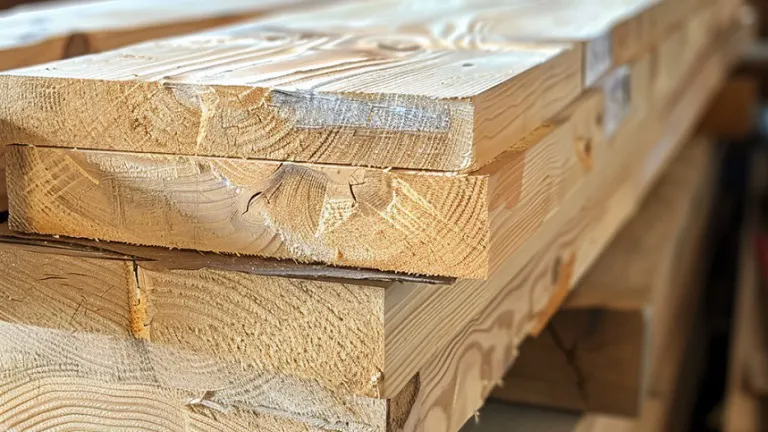Nominal Lumber Sizes Explained: Complete Reference Guide
- April 3, 2024
- 0 comment

Lumber forms the foundation of woodworking and construction projects, from basic structures to elaborate designs. However, navigating nominal lumber sizes, which differ from actual dimensions, can be challenging. This guide will help you understand and select the appropriate lumber for your project.
The Basics of Lumber Measurement
Lumber is simply wood processed into beams and planks. These dimensions, called nominal sizes, reflect the size before drying and planing, which reduces them to slightly smaller actual sizes.
Nominal vs. Actual Dimensions
Lumber sizes can be tricky! The size listed on the label (nominal size) is not quite the actual size of the wood. This is because lumber is dried and planed after it’s cut to size, which shrinks and smoothes the wood slightly. The table above shows this difference for both softwood and hardwood. For softwood, like pine or spruce, the nominal size includes both the width and thickness. A common 2×4 for example, is actually 1.5 inches thick by 3.5 inches wide. Hardwood lumber is a bit more complex. Nominal sizes often only indicate thickness, and the wood may be surfaced on one or two sides (S1S or S2S) which further reduces the size. Additionally, hardwood is typically sold by volume (board feet) rather than just by dimension. So, understanding both nominal and actual sizes is important to ensure you buy the right amount of wood for your project.
Nominal vs. Actual Lumber Sizes – Reference Table
| Wood Type | Nominal Size (in inches) | Actual Size (in inches) | Notes |
|---|---|---|---|
| Softwood | 1 x 2 | 3/4 x 1-1/2 | Common for trim work, shelving, and furniture building. |
| 1 x 3 | 3/4 x 2-1/2 | Used for shelving, furring strips, and blocking. | |
| 1 x 4 | 3/4 x 3-1/2 | The “workhorse” for many projects – wall studs, framing, and trim. | |
| 1 x 5 | 3/4 x 4-1/2 | Wider trim boards, project panels, and shelving. | |
| 1 x 6 | 3/4 x 5-1/2 | Wider trim boards, shelving, and project panels. | |
| 1 x 8 | 3/4 x 7-1/4 | Common for project panels, siding, and thicker trim. | |
| 1 x 10 | 3/4 x 9-1/4 | Project panels, shelving, and thicker trim. | |
| 1 x 12 | 3/4 x 11-1/4 | Used for wider project panels, shelving, and beams. | |
| 2 x 2 | 1-1/2 x 1-1/2 | Square posts, railings, and furniture building. | |
| 2 x 3 | 1-1/2 x 2-1/2 | Studs, rafters, and general framing. | |
| 2 x 4 | 1-1/2 x 3-1/2 | The most common framing lumber for walls, floors, and roofs. | |
| 2 x 6 | 1-1/2 x 5-1/2 | Stronger beams, headers, and larger framing applications. | |
| 2 x 8 | 1-1/2 x 7-1/4 | Beams, headers, and larger framing projects. | |
| 2 x 10 | 1-1/2 x 9-1/4 | Beams, headers, and heavy-duty framing. | |
| 2 x 12 | 1-1/2 x 11-1/4 | Beams, headers, and large construction projects. | |
| 4 x 4 | 3-1/2 x 3-1/2 | Posts, columns, and fence construction. | |
| 4 x 6 | 3-1/2 x 5-1/2 | Large posts, beams, and heavy-duty applications. | |
| 6 x 6 | 5-1/2 x 5-1/2 | Large posts, beams, and heavy construction projects. | |
| Hardwood | 1/2 (S1S) | 3/8 (S2S) | Nominal thickness only – actual thickness will vary depending on S1S (Surfaced One Side) or S2S (Surfaced Two Sides). Sold by board foot (volume) |
| 5/8 (S1S) | 1/2 (S2S) | ||
| 3/4 (S1S) | 5/8 (S2S) | ||
| 1 (S1S) | 7/8 (S2S) | ||
| 1-1/4 (S1S) | 1-1/8 (S2S) | ||
| 1-1/2 (S1S) | 1-3/8 (S2S) | ||
| 2 (S1S) | 1-13/16 (S2S) | ||
| 3 (S1S) | 2-13/16 (S2S) | ||
| 4 (S1S) | 3-13/16 (S2S) |
History and Evolution of Lumber Sizing
Before standardized lumber sizes, builders cut wood based on project needs, leading to inconsistency. The Industrial Revolution increased demand for lumber, making standardization crucial for efficient production and distribution. This section explores the historical development of nominal lumber sizes and their impact on the industry.
Understanding the Nominal Dimension System
The nominal dimension system, while seemingly outdated, remains the cornerstone of lumber purchasing. Unlike the actual dimensions of the wood, nominal sizes reflect the pre-processed size before drying and planing. This section will explain this system and equip you with the knowledge to confidently select lumber for your projects.
Common Nominal Lumber Sizes and Uses
Nominal lumber sizes come in a range, each suited for specific applications in construction and woodworking. We’ll explore some common sizes and their typical uses:
- 2×4 (actual: 1.5″ x 3.5″): The workhorse of framing, used for walls, studs, and rafters.
- 2×6 (actual: 1.5″ x 5.5″): Ideal for floor joists, headers, and larger beams due to its increased strength.
- 4×4 (actual: 3.5″ x 3.5″): Provides robust support for posts, columns, and fence construction.
- 1×4 (actual: 0.75″ x 3.5″): Commonly used for trim work, shelving, and furniture building.
- 1×6 (actual: 0.75″ x 5.5″): A versatile choice for wider trim boards, decorative applications, and project panels.
Why Nominal Sizes Matter in Construction
Precise lumber selection is crucial for safe and successful construction projects. Nominal sizes provide a standardized reference point to ensure structural integrity and efficient material use. Here’s why understanding nominal sizes is essential:
- Structural Integrity: Using the correct nominal size lumber guarantees components like walls and floors meet the necessary strength requirements. Mismatched sizes can compromise the structural soundness of your project.
- Material Efficiency: Nominal sizes allow for accurate material calculations, minimizing waste and keeping project costs under control. Imagine the wasted lumber if walls framed with 2x4s were designed for 2x6s!
- Communication & Collaboration: Nominal sizes establish a common language between architects, engineers, and builders. This clear communication is vital for ensuring everyone is working with the same specifications.
Navigating Lumber at Retail Stores

Lumberyards and home improvement stores use nominal sizes to label and categorize wood. This industry standard allows clear communication between staff and customers. For example, requesting a “2×4” ensures everyone understands the size, regardless of the slight difference from the actual dimension.
Beyond size, consider factors like wood type, grade, and origin. These influence the lumber’s characteristics and suitability for your project. While knowledgeable staff can offer valuable advice, understanding nominal sizes empowers you to make informed decisions before shopping.
Cutting Nominal Lumber for Your Project

Now that you have your lumber, it’s time to cut it to size. Here’s where understanding nominal vs. actual dimensions becomes important. Remember, the actual size is slightly smaller than the nominal size. Failing to account for this difference can lead to wasted material and project delays.
Ensuring Accurate Cuts:
- Measure Twice, Cut Once: Double-check your measurements using a reliable tape measure before each cut.
- Utilize Squares: Use squares to ensure straight and accurate cuts. Marking your cutting lines beforehand also helps with precision.
- Consider Wood Properties: Different wood types require adjustments in cutting technique. Denser woods may require a slower cutting speed for clean results.
Keeping Lumber Costs Under Control
Material costs can significantly impact any project’s budget. Here’s how understanding nominal sizes can help you save:
- Minimize Waste: Accurate estimates based on actual lumber dimensions reduce wasted cuts and unnecessary material purchases.
- Choose Cost-Effective Options: Knowing how lumber is priced (by size, type, and grade) allows you to select the most economical option for your project needs.
- Consider Multi-Cuts: Sometimes, buying a larger board and cutting it into smaller pieces can be cheaper. However, plan carefully and ensure the larger piece has the required properties (strength, grain) for the final cuts.
Sustainability and Nominal Lumber Sizing
Environmental responsibility is a growing concern in construction. Here’s how understanding nominal sizes can contribute to sustainability:
- Reduce Lumber Waste: Accurate project planning based on actual lumber dimensions minimizes offcuts and wasted material. This translates to a lower demand for raw lumber and reduced environmental impact.
- Choose Sustainable Lumber: Look for lumber sourced from responsibly managed forests or certified by organizations promoting sustainability. Paired with efficient material use, this supports eco-conscious building practices.
Evolving Lumber Production: Innovation and Sustainability
The lumber industry embraces change. Advancements in milling, treatment processes, and composite materials are transforming wood possibilities. These innovations often lead to:
- Precise and Consistent Sizing: Improved technology minimizes size variations, reducing waste and simplifying project planning.
- Reduced Lumber Waste: New techniques optimize wood utilization, lowering environmental impact.
- Enhanced Durability: Advanced treatments improve the lifespan of lumber products.
Engineered wood products like LVL and CLT are particularly exciting. Made by bonding wood layers, these materials offer superior strength, flexibility, and reliability compared to traditional lumber. They not only expand design possibilities but also promote efficient wood resource utilization.
Mastering Nominal Lumber Sizes: Expert Tips
Conquering nominal lumber sizes is easier than you think! Here are some pro tips:
- Double-Check Dimensions: Always measure actual lumber before cutting to ensure it meets project needs.
- Plan for Shrinkage: Account for extra shrinkage if using green lumber, as it dries.
- Match Lumber to Project: Select size and type based on your project’s structure and desired look.
- Minimize Waste: Plan cuts to reduce scrap; use offcuts for smaller project elements.
- Stay Updated: Keep informed about industry changes that might impact lumber sizing and availability.
Conclusion
In conclusion, Picking out lumber can be confusing because the sizes listed (nominal sizes) are slightly bigger than the actual wood you get. This guide explains the difference! Nominal sizes reflect the wood’s size before drying and planing, so a 2×4 for instance is actually 1.5 inches thick by 3.5 inches wide. Understanding this is important to buy the right amount of wood, ensure strong structures, and make accurate cuts to avoid waste. This guide even has a table with common nominal and actual sizes for both softwood and hardwood, along with tips for picking lumber and saving money. So next time you’re at the lumber yard, you’ll be a pro!
FAQs
- What are nominal lumber sizes?
- Nominal lumber sizes refer to the dimensions given to lumber before it undergoes drying and planing processes, which result in slightly smaller actual dimensions. These sizes are typically what you see labeled in stores.
- Why do nominal and actual lumber sizes differ?
- The difference arises because lumber is initially cut to nominal dimensions, and then it shrinks slightly and is smoothed during the drying and planing processes, resulting in the actual, slightly smaller dimensions.
- How can I convert nominal sizes to actual sizes?
- You can refer to conversion tables that list both nominal and actual dimensions for different types of lumber, such as softwoods and hardwoods. These tables provide a quick reference for understanding the true size of the lumber you’re working with.
- Why are nominal sizes still used if they’re not the actual dimensions of the lumber?
- Nominal sizes provide a standardized reference for the lumber when it is first cut, which is important for consistency in the lumber industry. They also serve as a common language among professionals and DIYers for identifying and discussing lumber.
- Are nominal sizes the same for all types of wood?
- No, the difference between nominal and actual sizes can vary between softwoods and hardwoods. Softwoods are typically used in construction and have more standardized nominal to actual size conversions, while hardwoods, often used in furniture and cabinetry, might have more variability.
- How does the nominal size system impact my project planning?
- Understanding the nominal size system is crucial for accurate project planning. It ensures you purchase the right amount of material and that your structural components fit together correctly, especially in framing and construction projects.
- Can I rely on nominal sizes when ordering lumber for a project?
- Yes, you can use nominal sizes to order lumber, but it’s essential to be aware of the actual sizes for precise cuts and fittings. Knowing both helps in communicating effectively with suppliers and ensuring the material meets your project’s requirements.
- How should I handle lumber sizing when working on a detailed project?
- For detailed projects, it’s important to measure the actual dimensions of each piece of lumber you plan to use, considering the nominal vs. actual size differences, and adjust your plans or cuts accordingly to ensure accuracy.
- What should I do if my project requires very specific dimensions not covered by nominal sizes?
- If your project requires specific dimensions that don’t align with standard nominal sizes, you can purchase larger pieces of lumber and cut them down to your needed size, or consult with a lumber specialist for custom milling options.
- How can understanding nominal sizes help me save money on lumber?
- By understanding the actual dimensions you’ll get from nominal-sized lumber, you can plan your projects more accurately, reducing waste and avoiding the purchase of excess material. Additionally, being informed can help you make more cost-effective choices when selecting lumber grades and types for your project.

Charles Hayes
Forestry AuthorI'm Charles Hayes, I bring over 15 years of specialized expertise in landscaping and woodworking, blending artistic design with sustainable environmental stewardship. My career, fueled by a profound passion for the natural world, encompasses extensive education and hands-on experience in creating harmonious, eco-friendly outdoor spaces and responsibly managing forest resources. Recognized for my professional standing, I am committed to continuous learning and certification in cutting-edge practices. My expertise is not only reflected in my work but also in my contributions to community projects, educational workshops, and collaborations with industry leaders. As an authoritative voice in my field, I strive to share knowledge and promote environmentally conscious approaches, making me a trusted resource in landscaping and forestry.













Leave your comment